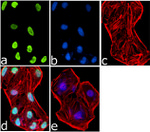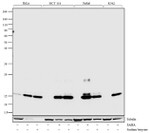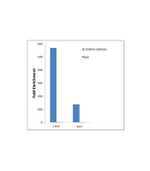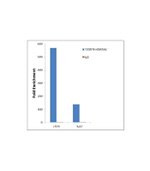Search Thermo Fisher Scientific
Invitrogen
H2AK5ac Polyclonal Antibody
This Antibody was verified by Relative expression to ensure that the antibody binds to the antigen stated.
FIGURE: 1 / 4
H2AK5ac Antibody (720070) in ICC/IF




Product Details
720070
Species Reactivity
Host/Isotype
Class
Type
Immunogen
Conjugate
Form
Concentration
Purification
Storage buffer
Contains
Storage conditions
Shipping conditions
RRID
Product Specific Information
These Polyclonal antibodies are of rabbit origin developed by immunizing animals with proteins or peptides. The polyclonal antibody is purified by affinity purification from the rabbit sera generated after immunizing the rabbits with a specific type of protein or peptide. The purified antibody is tested for its functionality in various relevant research applications. The antibody is developed for Research Use Only and is non-hazardous or non-infectious in nature.
Since it is conserved across species, the antibody may react with many other species.
Target Information
Histones are basic nuclear proteins that are responsible for the nucleosome structure of the chromosomal fiber in eukaryotes. Two molecules of each of the four core histones (H2A, H2B, H3, and H4) form an octamer, around which approximately 146 bp of DNA is wrapped in repeating units, called nucleosomes. The linker histone, H1, interacts with linker DNA between nucleosomes and functions in the compaction of chromatin into higher order structures. This gene is intronless and encodes a member of the histone H4 family. Transcripts from this gene lack polyA tails but instead contain a palindromic termination element. This gene is found in the large histone gene cluster on chromosome 6.
For Research Use Only. Not for use in diagnostic procedures. Not for resale without express authorization.
References (0)
Bioinformatics
Protein Aliases: Acetyl-Histone H2; Acetyl-Histone H2A K5; Acetyl-Histone H2A Lys5; H2A 615; H2A GL101; H2A histone family member; H2A histone family, member A; H2A histone family, member C; H2A histone family, member E; H2A histone family, member G; H2A histone family, member M; H2A histone family, member P; H2A histone family, member R; H2A histone family, member X; H2A histone family, member Z; H2A-clustered histone 1; H2A-clustered histone 12; H2A.1; H2A/d; H2a/x; H2A/z; h2ad; H2ae; h2ai; H2ak; H2AK5ac; H2ALys5ac; H2AX histone; H2AZ histone; H2B histone family, member U, (testis-specific); HIS; HIST3H2A; histone 1, H2aa; histone 1, H2ab; histone 1, H2ad; histone 1, H2ae; histone 1, H2ag; histone 1, H2ai; histone 1, H2aj; histone 1, H2ba; Histone H2A type 1; Histone H2A type 1-A; Histone H2A type 1-B/E; Histone H2A type 1-D; Histone H2A type 1-H; Histone H2A type 1-J; Histone H2A.2; Histone H2A.3; Histone H2A.X; Histone H2A.Z; Histone H2A/a; Histone H2A/e; Histone H2A/g; Histone H2A/m; histone H2A/p; Histone H2A/ptl; Histone H2A/r; Histone H2A/s; histone H2AD; histone H2AE; Histone H2AX; Histone H2B type 1-A; Histone H2B, testis; MGC74460; Testis-specific histone H2B; TSH2B.1
Gene Aliases: bA317E16.2; bA317E16.3; dJ160A22.4; dJ86C11.1; H2A.1; H2A.1b; H2A.2; H2A.3; H2A.X; H2A.z; H2A.Z-1; H2A/a; H2A/c; H2A/E; H2A/g; H2A/m; H2A/p; H2A/S; H2A/X; H2A/z; H2AA; H2AC1; H2AC11; H2AC12; H2AC13; H2AC14; H2AC15; H2AC16; H2AC17; H2AC4; H2AC7; H2AC8; H2AFA; H2AFALii; H2AFC; H2AFD; H2AFE; H2AFG; H2AFI; H2AFM; H2AFN; H2AFP; H2AFR; H2AFX; H2AFZ; H2AG; H2AH; H2AX; H2AZ; H2AZ1; H2BC1; H2BFU; HIST1H2AA; HIST1H2AB; HIST1H2AD; HIST1H2AE; HIST1H2AG; HIST1H2AH; HIST1H2AI; HIST1H2AJ; HIST1H2AK; HIST1H2AL; HIST1H2AM; HIST1H2BA; pH2A/f; STBP; TH2A; TH2B; TSH2B; TSH2B.1
UniProt ID: (Human) P16104, (Human) P0C0S5, (Human) Q96QV6, (Human) P04908, (Human) P20671, (Human) P0C0S8, (Human) Q96KK5, (Human) Q99878, (Human) Q96A08
Entrez Gene ID: (Human) 3014, (Human) 3015, (Human) 221613, (Human) 8335, (Human) 3013, (Human) 3012, (Human) 8969, (Human) 85235, (Human) 8329, (Human) 8331, (Human) 255626

Performance Guarantee
If an Invitrogen™ antibody doesn't perform as described on our website or datasheet,we'll replace the product at no cost to you, or provide you with a credit for a future purchase.*
Learn more
We're here to help
Get expert recommendations for common problems or connect directly with an on staff expert for technical assistance related to applications, equipment and general product use.
Contact tech support
